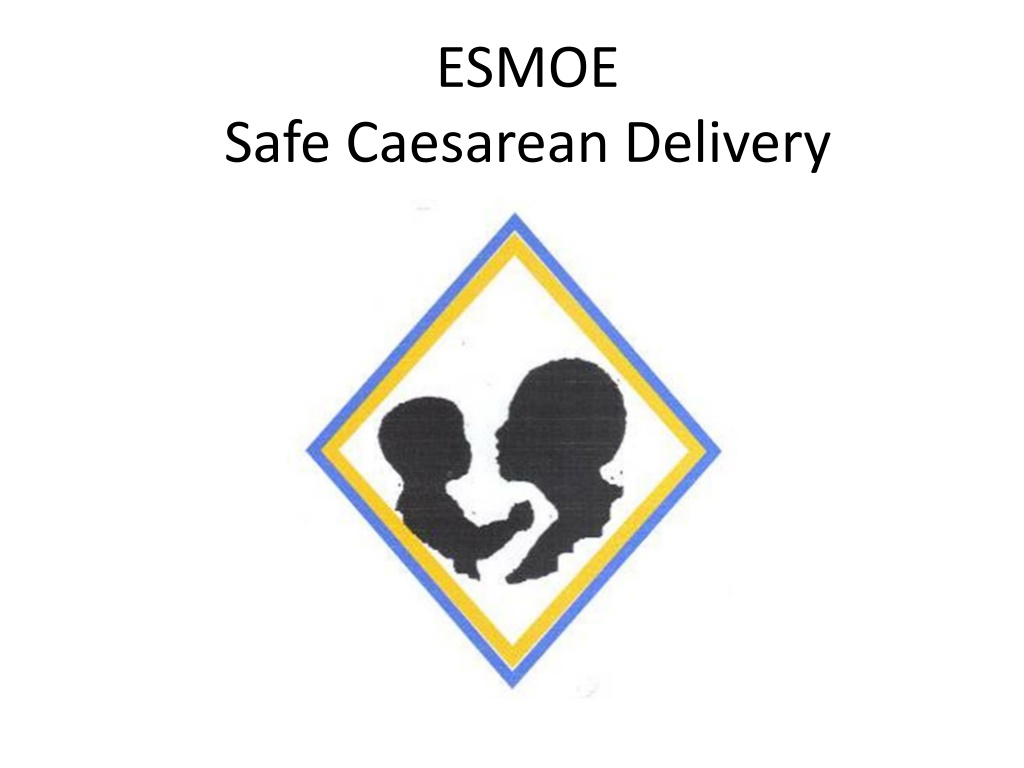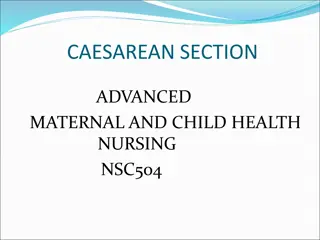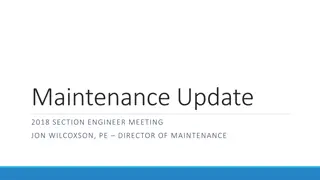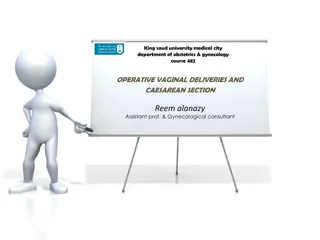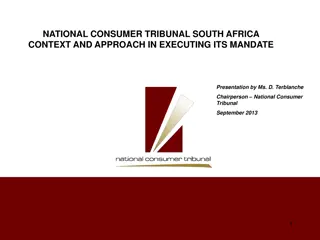Risks and Strategies for Safe Caesarean Deliveries in South Africa
Understanding the mortality burden related to caesarean deliveries (CD) in South Africa, this report highlights the need for safe CD practices amidst high maternal death rates. Factors influencing safe CD, checklists for accreditation, and strategies for action plans are discussed. The Case Fatality Ratio (CFR) comparison between CD and vaginal delivery reveals higher risks associated with CD, particularly due to causes like hypertension, sepsis, embolism, and bleeding. The increasing case fatality rate for bleeding at/after CD underscores the urgency in monitoring and implementing safe practices for CD deliveries.
Download Presentation

Please find below an Image/Link to download the presentation.
The content on the website is provided AS IS for your information and personal use only. It may not be sold, licensed, or shared on other websites without obtaining consent from the author. Download presentation by click this link. If you encounter any issues during the download, it is possible that the publisher has removed the file from their server.
E N D
Presentation Transcript
ESMOE Safe Caesarean Delivery
Aims To understand the burden of mortality related to caesarean delivery (CD) in South Africa To understand the clinical, administrative and managerial factors required to enable safe CD To describe checklists for accrediting surgeon, anaesthetists and facility for safe CD To discuss strategies to implement Safe CD action plans in a district, with rational use of resources To acquire skills for monitoring CD rates and CD case fatality rates.
Background: Sixth Saving Mothers report 2011-2013 655,686 women were delivered with a Caesarean Delivery CD rate for SA: 23.1% (public sector), 67% (private sector) 1243 maternal deaths where a Caesarean delivery was the mode of delivery 1471 deaths after vaginal delivery
Case Fatality Ratio (CFR) for CD Number of deaths within a defined population (CD cases) expressed per 10 000 CFR for CD delivery was 1243/655 686 = 18.9/10 000 CFR for vaginal birth 1471/2175380 = 6.7/10 000 THE RISK OF DYING WHEN DELIVERED BY A CD WAS 2.8 TIMES HIGHER THAN VAGINAL DELIVERY Limitations of CFR- difficult to separate risk of disorder for which CD was done (e.g. eclampsia) from risk of procedure itself
Relationship between primary cause of maternal death and route of delivery Hypertension - risk of dying almost 6 times increased with CD compared to vaginal delivery Sepsis - 3 times the risk with CD Acute collapse/embolism - 5 times increased risk with CD Bleeding during and after CD Anaesthetic deaths
Deaths from Bleeding associated with Caesarean delivery
Deaths from Bleeding at/after Caesarean delivery Maternal deaths due to bleeding at or after CD 250 200 150 Number 100 50 0 2002-4 2005-7 2008-10 2011-13
Case Fatality rate for bleeding at CS is increasing 40.0 35.0 30.0 25.0 Case Fatality Rate (/100000 CD) 20.0 SA CD Rate (%) 15.0 10.0 5.0 0.0 2002-4 2005-7 2008-10 2011-13
Concerning: 70-72% of deaths due to bleeding associated with CD were assessed to be clearly avoidable Only 1.8% of these deaths were assessed as having no suboptimal care
Case Fatality Rate (per 100,000 CDs) for BLDACD deaths per type of facility 2014-2015 . DH RH Number CDs (CDR%) (23.8%) PTH 57145 (38.6%) NC 186986 176612 (36.9) 54380 (46.5%) Live births CFR Bleeding during Caesarean section CFR Bleeding after Caesarean section 785721 478535 148132 116,995 5.35 7.36 22.75 0.00 19.25 16.99 49.00 9.19 DH District Hospital; RH Regional Hospital; PTH Provincial Tertiary Hospitals; NC National Central
QUESTION A 1. What can be done to reduce deaths due to bleeding associated with Caesarean delivery? List two interventions.
What can be done? Prevention of excessive bleeding at/after CD Be prepared Early detection Immediate treatment Definitive treatment Timely, Safe and Appropriate referral Refer to PPH algorithms in PPH and CD monographs/ESMOE Aid.
Deaths from Anaesthesia at CD NB: Anaesthetic deaths: 2/3 spinal, 1/3 general
Anaesthetic deaths by level of care (2011-2013) District Regional Tertiary Private 1344 31.6% 1653 38.9% 972 22.9% 114 2.7% Total Deaths 57 37 8 1 Anaesthetic Deaths 55.3% 35.9% 7.8% 1.0% Number of CDs 233501 248556 160269 ?
Provincial variation in iMMR for anaesthesia (2011-2013) Province iMMR Limpopo 8.92 Mpumalanga 7.92 Eastern Cape 4.14 KwaZulu Natal 3.73 Free State 2.77 Northwest 1.73 Gauteng 1.47 Western Cape 0.36 Northern Cape 0 National Average 3.73
QUESTION A 2. What can be done to reduce deaths due to anaesthesia for CD? List two interventions.
What can be done? Anaesthetic training/accreditation Use of vasopressors for spinal anaesthesia Difficult scenarios: massive OH and eclampsia ESMOE module: spinal and GA Anaesthetic outreach and support to district hospitals Clinical officers? Avoid single operator/anaesthetist
QUESTION A 3. What can be done to reduce deaths from Puerperal sepsis following CD List two interventions.
What can be done? Prevent prolonged labour and multiple PVs Prophylactic antibiotics Adequate therapeutic antibiotics Early surgical intervention Postnatal care coverage
QUESTION A 4. What can be done to reduce deaths from Thrombo-embolism after CD ? List two interventions.
What can be done? Hydration Early mobilisation Thromboprophylaxis Early detection and treatment of VTE
Key responsibilities for Ensuring safe CD Facility/Theatre Management District/Provincial Management Clinical
Clinical responsibilities for safe CD Prevention of unnecessary CD Prevention and treatment of mortality and morbidity from Bleeding Sepsis Thromboembolism Anaesthetic complications (protocols, training, competency checklists, M&M)
QUESTION B What are the responsibilities of: facility /theatre mangers in reducing deaths from CD ? district and provincial managers List two responsibilities for each
Facility management responsibilities for safe CD Supplies Medicines Equipment Blood & FDPs Adequate numbers staff/ deployment (accreditation checklists/ needs analysis)
District/Provincial management responsibilities for safe CD Diversion resources to improve CD safety in identified facilities Stop CD at those which cannot provide safe service Balance safety with accessibility Prevention of overload at PTHs/ OMBUs Leadership, monitoring and accountability
SETTING MINIMUM STANDARDS FOR CD
SUMMARY - Minimum standards for caesarean delivery Requirement Standard Protocol Surgeon Anaesthetist Doctor, accredited Doctor, accredited Minimum of 2 accredited doctors in theatre throughout procedure: An accredited doctor on duty and on-site available at all times for obstetric emergencies. A 2nd accredited doctor, available within 30 minutes before intended anaesthetic starts. Surgeon s Assistant (must not be the same person as the anaesthetist) Doctor, intern, medical student, Clinical Associate, student Clinical Associate, Nurse or student nurse. On-site and present in theatre throughout procedure (or available within 30 minutes). Should preferably not be the scrub nurse. Newborn care Nurse, doctor or clinical associate with newborn resuscitation skills (must have completed Help Babies Breathe training or equivalent). On-site to receive baby (must be a separate person from the anaesthetist and the surgeon). Theatre nursing team Scrub nurse, anaesthetic assistant, floor nurse, (minimum requirement) Adequate recovery and observation with a person dedicated for the purpose of post- operative care. On site or on-standby to be on-site within 30 minutes Dedicated recovery area Follow protocol for post-CD care. Supplies At least 2 units emergency blood. At least 2 bottles of Freeze dried plasma (FDP). On-site. (See monographs for Safe CD and PPH, template). Immediate action to replace any units of emergency blood used. Safe care procedures Surgical safety checklist. Safe CD protocols (CS Monograph). CD audits (including outcomes and EMS delays). Use safety checklist for every CD. Display posters on walls. Indications reviewed for every CD. Reporting of all CD-related deaths to CEO within 24 hours; investigation initiated within 48 hours and reported to DCST / MCWH coordinator. PM mandatory. Regular review of indications, timing and procedure (at least weekly). indications and
TOOLS Checklists for facilities Competency Checklist surgeon Competency Checklist anaesthetist Surgical safety Checklist Detailed action plan
Facility accreditation- Free State checklist example Element Criteria -CD Criteria delivery unit Access to maternity waiting area access Access to interfacility transport access access Antenatal and postnatal beds access access Bed gap (% of 2030 provincial norm) 20% 25% Facility hospital regulation Listed as hospital Midwife/PN gap (%) 30% 25% Number of doctors accredited for surgery Proof of skills assessment Number of doctors accredited for anaesthesia Proof of skills assessment On-site maternity cover On-site MO after hours Onsite midwifery cover Piped oxygen in OT Piped oxygen supply in theatre Emergency electricity Theatre linked to emergency generator Functional anaesthetic machine Anaesthetic equipment with service record Signal functions performed routinely All 9 signal functions 7 signal functions
Competency check of surgeon WHO Interns, COSMOs, new MOs & Registrars BY WHOM Experienced supervisor (onsite/DCST) HOW Checklist as guideline/ At least 10 In reach/out reach/onsite Materials: ESMOE surgical skills, videos, CS monograph Routine and complicated Maintenance skills DOCUMENTATION Accreditation system per facility e.g. list accredited surgeons in theatre
Example of competency checklist for surgeon Item under observation Performed independently PLEASE TICK RELEVANT BOX Needs help Appropriate skin incision (e.g. length, position) Safe entry of peritoneal cavity Careful management of bladder Appropriate uterine incision (e.g. length, position) Safe and systematic delivery of baby Appropriate delivery of placenta Check uterine cavity (e.g. intact, empty, configuration) Safe securing of uterine angles Check for ovarian pathology Appropriate closure of rectus sheath Attention to haemostasis Neatness of skin closure Comments:
Assessing competence in anaesthesia for Caesarean Delivery Item under observation Performed independently Needs help Preoperative assessment Preoperative equipment check Resuscitation equipment check Intubation equipment check Patient preparation Draw up essential drugs Management of failed intubation Knowledge of action if cardiac arrest Recovery management
Generic Technical Skills Assessment after SPINAL and GA Poor Performance This is unacceptable as implies failed airway, failed resuscitation Not aware of potential complications and failed to prepare Area Fair Performance Good Performance Gaps in Preparation for Potential complications Careful planning to handle complications Preparation and Planning Poor handling of equipment, clumsy in use of needles, syringes and procedures Slick effective ivi access, lumbar puncture and intubation Achieves procedures, but lacking in finesse Technical Skills Unfamiliar and slow in application of Blood Pressure cuff, oximetry and following monitoring Preparing the team for actions, instructs them on expected roles (cricoid pressure, assist patient positioning etc.) Slick use of monitors to reliably assess physiological condition of patient Knowledge and handling of equipment Unable to utilise monitors to assess patient conditions Technical Use of Assistants and relations with patient and surgical team Unable to utilise team members to achieve safe anaesthesia Full control of the theatre team to ensure optimal outcome Fully understands areas of weakness and has plans to correct the issues Poor Understanding of areas of Weakness Some understanding of areas of Weakness Insight and attitude Adequate documentation but some omissions or areas that need elaborating Comprehensive legible documentation indicating procedure Limited Documentation, poorly written Documentation
SA, 2016: Caesarean delivery safety checklist SIGN IN (To be said out loud before induction on anaesthesia) TIME OUT (To be said out loud before skin incision) SIGN OUT (To be said out loud before patient leaves the operation room) Patient has confirmed Identity Procedure Consent Confirm all team members have introduced themselves by name and role Practitioner verbally confirms with the team: Name of the procedure and any additional procedure has been recorded? Instruments, swabs and sharp counts are correct? Specimens have been labelled? Blood loss has been recorded? To Surgeon Anaesthesia safety check completed (Equipment and medication) Are there any potential problems the team should be aware of? No Yes Mothers rhesus status known Does cord blood need to be taken? No Yes Neonatal safety check completed (Equipment and medication) Pulse oximeter on patient and functioning Is a difficult airway anticipated? No Yes and equipment and assistance is available To Anaesthetist: Wedge placed? Any patient specific concerns? Does patient have a known allergy No Yes Obstetrician, Anaesthetist and Scrub Nurse have discussed: To Scrub Sister Concerns for recovery and further management? Need for post-operative VTE prophylaxis? Need for postoperative antibiotics? Equipment problems that have been identified? Oxytocin 20 IU in 1000mls IVI running at 125mls/hour Assess bleeding risk (Pre op Hb .. g/dl) Risk factors for PPH. No Yes (i.e. prolonged labour, multiple pregnancy, big baby, polyhydramnios, grand multiparity, clotting dysfunction, PPH in the past). If yes, There is adequate IV access? Is emergency blood available? No Yes Are there any concerns about the placental site No Yes Sterility of instruments confirmed Any equipment issues / concerns Diathermy and suction functional Midwife has confirmed that Baby/ies been correctly labelled? Relevant cord bloods have been taken, if relevant? Antibiotic prophylaxis give in the last hour? Appropriate / recent antacid prophylaxis given? Urinary catheter is draining Patient Name: _________________________________ Patient Surname:_______________________________ Are any additional procedures planned? IUCD BTL N/A Date of Birth:__________________________________ Hospital number:______________________________ Date of Surgery:_______________________________ Is the foetal heart present? No Yes NAME AND SIGNATURE OF HEALTHCARE WORKER
QUESTION C How could you monitor caesarean delivery outcomes and safety in your facility? List three indicators that could be used for this.
Routine monitoring Caesarean rate = number CDs/Total deliveries x100% Robson classification for CD Case Fatality rate = number BLDACD / total CDs x10000 Near Miss rate per CD =number near miss (haemorrhage, bladder or bowel injury, high spinal ) /total CDs x 1000 Per facility/per district Per month/per year
Robson classification for caesarean delivery: global standard 1. Nullipara >37wks spontaneous labour 2. Nullipara >37 wks. IOL or ELCS 3. Multipara >37 wks. Spontaneous labour 4. Multipara >37 wks., IOL or ELCS 5. Multipara, one or more previous CS 6. Nullipara. Breech 7. Multipara. Breech 8. Multiple pregnancies 9. Transverse or oblique presentation 10. Singleton <37 weeks
Recap Problem of CD mortality and morbidity in SA Clinical management of major problems Minimum standards for a facility providing CD Strategies to ensure compliance with minimum standards District planning of maternity services to enable safe CD Surgical safety checklist and accreditation tools Monitoring and auditing
